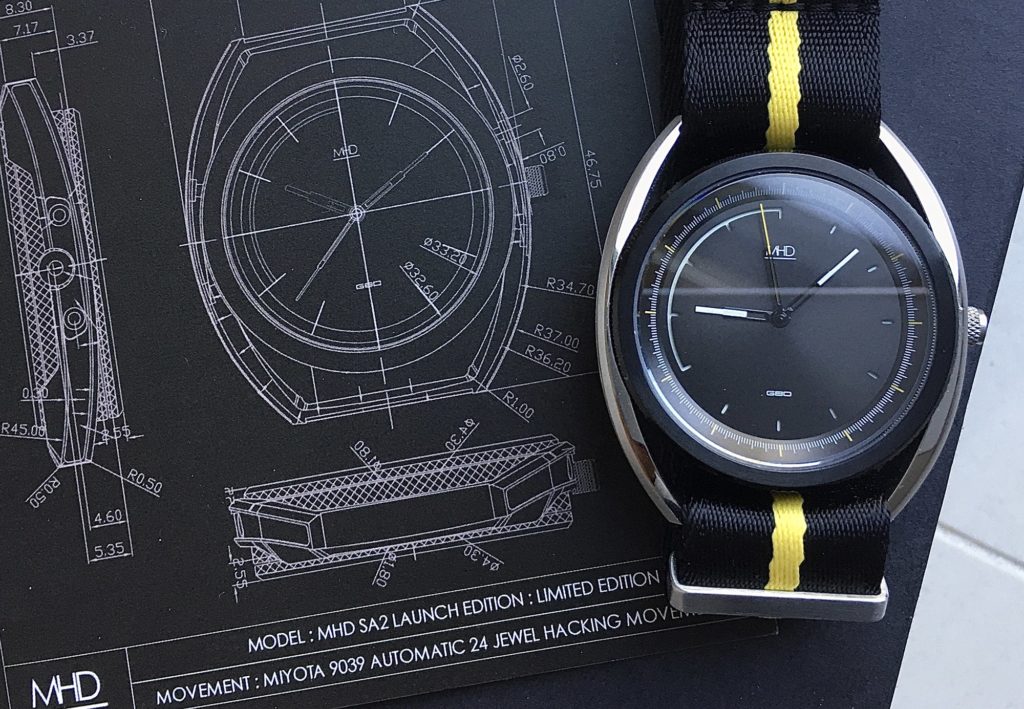
Having always been curious about MHD watches, I was anxious about finally being able to handle one. Why anxious? Because even for designs that you may be relatively familiar with, the reality can often surprise you. This anxiety tends to increase for designs that you have no benchmark for, as is the case with the MHD SA2 limited edition. The pun is very much intended, given that the SA2 has one of the most daring case designs I have seen coming out a micro-brand.
Weighing in at 41mm in diameter and 10mm tall, the SA2 houses a Miyota 9039 automatic movement. The rest of the technical information is on their website, but if you plan on buying this piece, it wont be for the specs. Strongly influenced by the suspension wishbones of hill climb cars, the SA2’s case is clearly where the show is at.

Matthew should be congratulated for this genuinely unique and interesting expression of case design. Having gotten rapidly acquainted with hill climb cars and their particular features, you can definitely see where Matthew is coming from with this piece. The exo-skeleton chassis is replete with all kinds of wonderful and unexpected curves and lines: giving the chassis a sculptural and structurally sound quality. Nestled within the chassis is the black DLC-coated barrel that houses the movement and dial. It is an aggressive looking thing, and would probably say something mean to you if it could talk However, the protective embrace of the chassis took some of the edge away (literally…the knurling is actually a bit sharp if you’re not careful), and balances out the case nicely. In fact, you would think that all these complicated bits and pieces would make for a rather chunky watch: you would be wrong. The way the chassis curves downward towards the lugs, lowers the profile of the case, and helps it sit closer to the wrist. The flat crystal shaves off some height too. Overall, I thought it was an innovative way of merging elegant, sculptural features with grittier, more industrial elements.

Within the dial, we see further evidence of Matthew’s design pedigree and expertise. As my first experience with a cut-out/sandwich dial, and I was not disappointed: the laser cut hour markers on the dial are crisp and well-proportioned in relation to the markers on the chapter ring. The speedometer-styling of the hour markers in the top left quadrant of the dial, is as obvious an indicator of this watch’s racing heritage as you can get, and is also a nice way to break up the symmetry of an otherwise plain dial. As a complement to the cut-out hour markers, the skeletal architecture of the hands continues the theme of expressing presence through absence, which we also see in the chassis itself.

However, the subtleties of the case and dial are (in my opinion) best enjoyed without the strap.
…uh what?
Yeah. Weird, I know. But I found that the only way I could enjoy the watch, was to unthread the strap and just play with the naked case in my palm, holding it up to the light to appreciate it from different angles.

So what is my beef with the strap you ask?
I believe that the choice of a long seatbelt nato strap cripples the diligently carved silhouette of the case. The thickness of the strap adds considerable height to an otherwise slim profile. This in itself is not the main issue, given that even with the strap, the watch doesn’t sit that high on the wrist. The issue, is why would you go to the effort to creating that graceful downward sloping chassis, and then obscure bits of it with a nato? The same issue presents itself when it comes to length: the folded strap bulges out at the lugs, and hides the solid spring bars that are a fairly integral element of the exo-skeleton design.
Ah but Sean you simpleton. Can’t you see that the inevitable outcome of a solid-springbar-chassis is that a nato strap must be used?
Yes and that’s exactly what makes this so frustrating. Understandably there are a multitude of design and cost considerations that go into making a steel bracelet, but my humble suggestion is that some kind of integrated steel bracelet would have been much more appropriate. As a smaller brand, the cost of producing a steel bracelet may add an unacceptable premium to the sale price of a watch, so I can understand it from that perspective. But from a design standpoint, wouldn’t a steel band of some kind have fit the aesthetic of a race-car inspired watch, a lot better?
At the end of it all, I am conflicted. At 645 GBP, the MHD SA2 represents considerable value for its authentic design, but feels a lot like if a beautiful painting was hung in a dollar store frame. If a nato strap really does not bother you in the slightest, and if you think the aesthetic is perfect, then by all means, buy this watch. However, if you are a bit of a stickler for cohesiveness (or just hate natos), then perhaps wait till MHD does a version on a bracelet.
To have a look at all of the MHD watch offerings visit their official website here. If you’re after a very similar watch with a steel bracelet you can always have a look at the MHD AGT Collection.
Leave a Reply